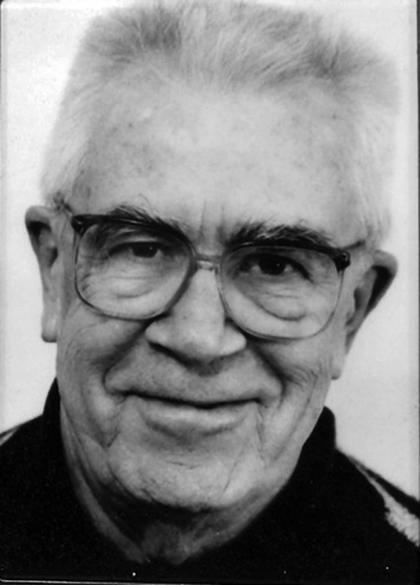

Main navigation | Main content

Paul O'Connor, a former professor in the Department of Chemistry, has died. A memorial service will be conducted, Saturday, April 20, 2013, at Walker Place, 3701 Bryant Ave. S., Minneapolis. Visitation at 4 p.m., celebration at 4:30 p.m. In lieu of flowers, memorials may be given to the Textile Center of Minnesota.
By Pat Doyle
published March 26, 2013
StarTribune
http://www.startribune.com/local/200156281.html
Young and healthy, Paul O’Connor drew stares as he rode the bus in Chicago during World War II, when fit men were expected to be serving in the military overseas.
What other passengers didn’t know was that O’Connor was serving his nation in a top secret mission that would change war forever.
The Manhattan project at the University of Chicago tapped the brains of America’s most brilliant scientists, including O’Connor, a junior chemist whose work helped create the atomic bomb.
A longtime professor at the University of Minnesota, O’Connor died in Minneapolis this month. He was 92.
He developed mixed views about the Manhattan project and in 1945 joined 154 other scientists in signing a petition to President Harry Truman warning of the destructive power of the bomb and urging him not to use it unless Japan refused to submit to published terms of surrender. The petition never made it to Truman, who authorized the nuclear bombing of Hiroshima and Nagasaki.
“Ever since then he’s been fairly opposed to nuclear weapons and nuclear power,” said O’Connor’s son, Mike.
After the war, O’Connor turned his skills to improving education for high school students. As with the Manhattan project, there was a national sense of urgency.
The Soviets had embarrassed the U.S. in 1957 by launching the space satellite Sputnik, and the breakthrough raised questions about whether American math and science education was good enough.
“There was a real fear that the Russians would outstrip us,” said O’Connor’s daughter, Maggie.
She said her father, then teaching chemistry at the University of Minnesota, was among the scientists who helped develop an easier-to-understand chemistry curriculum for high school students in the 1960s to respond to the challenge.
His work caught the attention of India, which was trying to ramp up its technical skills. With help from the National Science Foundation, O’Connor and his family lived off and on in India over several years and helped upgrade its higher education.
“He felt very lucky to work over there,” Maggie said. “It was considered a hardship post, but it was not hardship for us.”
O’Connor’s teaching career came to an end in the early 1970s after he developed a medical condition that left him with halting, quieter speech. He retired from the U and turned his energies to weaving. The change wasn’t as dramatic as it might seem.
“The math and geometry that goes into weaving was straight out of the chemistry that he used to do,” Mike said.
Veteran weaver Paula Pfaff said O’Connor quickly became a standout in his new field and specialized in doubleweave, a particularly difficult pattern.
“He had a national reputation,” Pfaff said. “He was creative ... When Paul explored something, he explored it to the max.”
In addition to his son and daughter, O’Connor is survived by his grandchildren Elliot, Dan, Robert and Richard. He was preceded in death by his wife Pat.
Paul O'Connor,
92, died at Abbott Northwestern Hospital after a brief illness. He was
born in Milwaukee, WI, on February 3, 1921, to Arthur and Helen (Radell)
O'Connor. He attended Haverford College where he majored in chemistry
and mathematics (with, he liked to add, a minor in Bridge). During
graduate school, he participated in a program in the Manhattan Project
isolating isotopes of plutonium. He signed the Szilárd petition in 1945,
urging President Harry Truman not to use the atomic bomb against people
without first offering an observed demonstration.
In 1947, he
became a professor at the University of Minnesota. The focus of his work
changed after Russia put the Sputnik into orbit prompting a national
effort to upgrade science and math education in the United States. He
helped to develop and promote CHEM study, a new curriculum for high
school chemistry. Because of this work, he was invited to introduce the
curriculum in India, and he spent about 5 years there between 1964 and
1973. He retired after 26 years for medical reasons and took up his
second career as a weaver. He applied his mathematical mind to complex
double weave and continued to experiment, teach and publish for the next
40 years until the time of his death, which occurred shortly after
putting a new warp on his loom.
He is survived by his children
Mike (Marcie Archer) O'Connor, Maggie (Linda Ridlehuber) O'Connor and
his grandchildren Elliot, Dan, Robert and Richard O'Connor. He was
preceded in death by his wife Pat O'Connor, parents Arthur (Helen
Radell) O'Connor, brothers John, Bob, Gary and Neal, and sister Jean
Kelley.